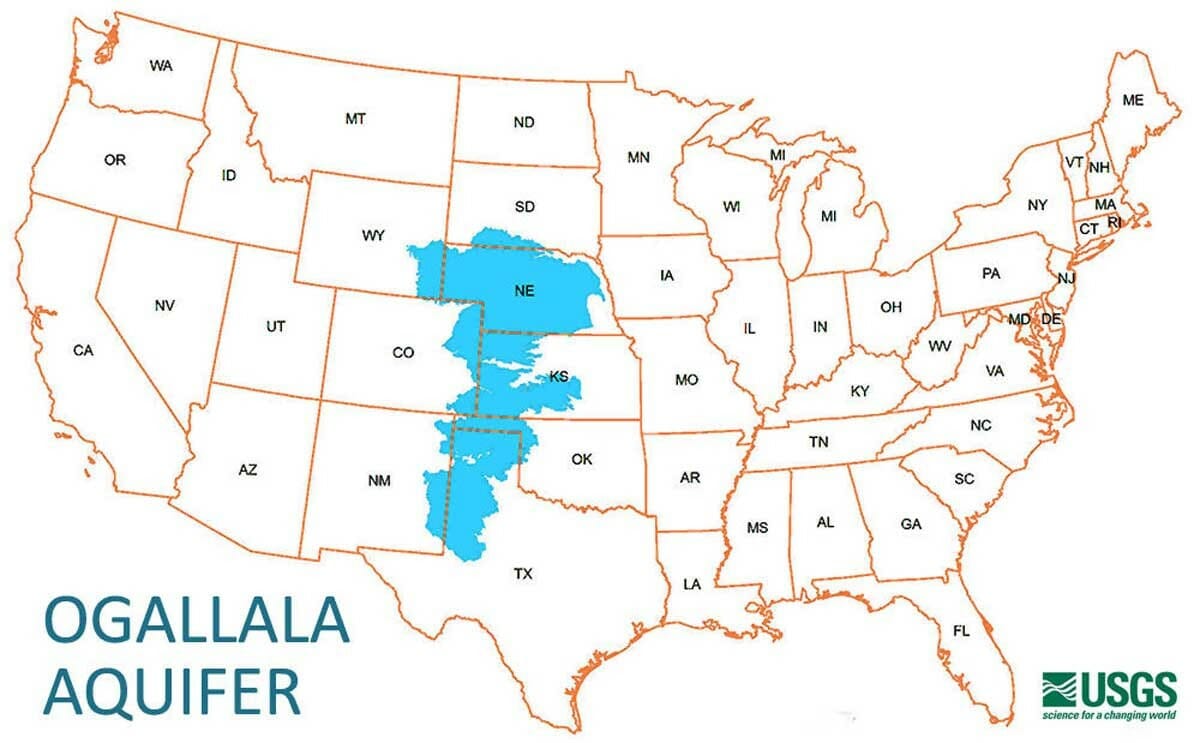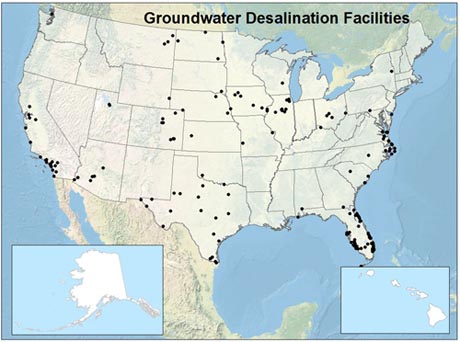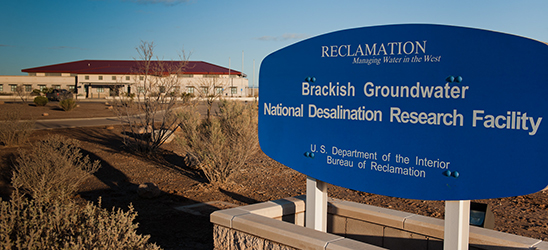
Eunice, the second smallest city in Lea County, may have struck clear liquid gold in its attempt to solve the increasing water crisis of the region, a crisis that exists throughout the entire of New Mexico but is unique in Lea County.
The Eunice City Council is moving forward with a plan to investigate the feasibility of a desalination plant to supply the city with fresh water.
The Hobbs consulting firm of Pettigrew and Associates has been hired to do the engineering study to determine feasibility at a price tag of about $464,000. The funds for the study are being supplied from the state’s coffers.
Diminishing Resources
Lea County sits on the edge of the Ogallala Aquifer, which stretches all the way from South Dakota to a point farther south in Texas. Unfortunately, only a thin edge of the aquifer creeps into a part of Lea County, a factor that is problematic for the water supply in the area.
To be specific, the aquifer varies in thickness from 1,200 feet in Nebraska to mostly between 0 and 50 feet in Lea County. Because Lea County is at the edge and in an area in which the formation is very thin, the county is more strongly affected by the depletion of the aquifer than some of the other areas under which the aquifer flows.
The ongoing depletion of the Ogallala Aquifer is alarming, and this depletion is a point of concern in most areas where the aquifer is the source of groundwater. The aquifer’s yearly groundwater withdrawals have quintupled between 1949 and 1974. In some areas of the aquifer, farmers have been withdrawing as much as four to six feet a year, while nature itself only replaces about half-an-inch of the drop off.
To paint a graphic image, in 1975 the Ogallala Aquifer water overdraft equaled the entire flow of the Colorado River, but today the water is being depleted at an annual volume equivalent to 18 Colorado Rivers. Although nature does recharge the aquifer through precipitation and river systems, the effects are mostly felt in the northern part of the aquifer, and in no place within the system is nature able to keep up with human demands.
Lea County’s Needs Are Different
Lea County is unique in New Mexico as the Lea County Regional Water Plan (PDF) is tied to adjacent areas in Texas, rather than to the rest of New Mexico. Although water users in Lea County have a great deal in common with each other, most of the things that influence the lives of Lea County water users are to a large extent unique to Lea County and not shared by adjacent New Mexico counties.
The simple truth is that when it comes to water, Lea County is far more connected to adjacent counties in Texas than it is to most other counties in New Mexico. Because of this the Lea County Water Users Association (LCWUA) has been encouraged by the New Mexico Interstate Stream Commission (NMISC) to include the area within Lea County but not the areas in New Mexico outside of Lea County.
Vast Resources of Potential Water
As most oil workers know, water exists everywhere underground. Unfortunately, most of this underground water is brackish or saltwater. A new nationwide study has unearthed the huge, hidden potential of tapping into salty aquifers as a way to relieve the growing pressure on freshwater supplies across the United States.
The amount of salt in saltwater is referred to as its “salinity”. Water salinity varies from formation to formation, but enough brackish water exists underground to more than meet the current human use of fresh groundwater by a factor of 35. These brackish aquifers exist in every state of the US except New Hampshire and Rhode Island. The obvious problem, though, is that humans (and farms) can’t consume saltwater and need freshwater to survive.
Right now, the mining and the oil and gas industries are the largest users of untreated, brackish groundwater; its salinity does not really affect the needs these industries have to use it. This salty cousin of freshwater is also ingested by some livestock species that can drink it when it exists in the lower salt concentration ranges, and it can be used as a water source for some salt-tolerant crops.
However, when it comes to the potential consumption of brackish water for municipal and human usage the Environmental Protection Agency (EPA) sets higher standards that require treatments to remove salts. EPA requirements, however, do not limit brackwish water from becoming a vital source of potable water for municipalities and humans alike through a process called desalination.
What Is Desalination?
Desalination is the process of removing dissolved solids from water. Although the removal of salt is the main goal of the process, other dissolved minerals are also removed in the process. Commercially, two technologies are currently in use – membrane desalination and thermal desalination.

Membrane desalination is most common in North America, being the process of forcing brackish or salt water through a membrane. This process is also called reverse osmosis (RO). Clean water is produced on one side of the membrane, and water with concentrated solids remains on the other side.
Thermal desalination, also called evaporative desalination, is used primarily in the Middle East, where the considerable amount of energy (oil and gas) needed for the process is very inexpensive locally. The thermal process heats the water until it evaporates leaving behind the solids; finally, the water vapor is captured and condensed back into liquid water.
In addition to the two processes described above, an emerging technology is on the horizon, and New Mexico is in the forefront of this unique method of desalination. The city of Cuba, located north of Albuquerque, is slated to become the first American city to use the Ion Exchange process to deliver clean water with nearly zero environmental impact.
The process was originally developed to clean up acid drainage from mining operations, but it can also be used to treat contaminated water from brackish aquifers. It is a zero discharge process, meaning that nearly 100% of treated water is converted into clean, fresh drinking water. Evaporation accounts for less than 4% of the treated water. Unlike other methods, the byproducts of the process, such as potassium nitrate, are packaged and then sold as agricultural fertilizers and other plant nutrients which partially subsidizes the process.
Desalination in New Mexico
Although desalination is a natural fit for New Mexico, currently Texas, California and Florida are the leaders in the field. These three states are credited with having the most number of brackish groundwater desalination plants.
Texas has 46 inland brackish desalination facilities, producing a year’s worth of water for 400,000 people. Looking at New Mexico, the state’s largest desalination project is the Alamogordo Brackish Water project, which produces, via the use of the membrane method (RO), one million gallons of fresh water per day from a brackish aquifer. The Alamogordo plant has the ability to expand its output to approximately 4 million gallons per day, if required. The waste concentrate from the facility is currently being pumped into a saltwater zone which is not suitable for desalination.
New Mexico is the Hub for Desalination Research
The Brackish Groundwater National Desalination Research Facility (BGNDRF), located near Alamogordo, opened on August 16, 2007. It was earmarked to be the focal point for developing technologies for the desalination of brackish and impaired groundwater found in the nation’s inland states. Researchers from other federal government agencies, research organizations, universities and the private sector work with state and local agencies in a collaborative partnership.

Classes are taught to city, state and federal employees, as well as to private individuals. The goal is always to educate people about desalination technology and its applications. Finding clean water sources for the public and fulfilling private needs, including farming and “off grid”, remain essential.
Currently, the BGNDRF is conducting research to develop cost-effective, hybrid units that combine processes utilizing wind or solar energy with desalination technologies. Investigations are, additionally, being conducted into finding alternative energy sources that have the potential to greatly reduce the costs of desalination, including fuel cells, geothermal, microwave and others.
Desalination is the Future for Lea County
One thing that nearly everyone can agree on is that New Mexico will not have enough fresh groundwater to meat its needs in the future. This has long made finding a solution to the state’s water insecurity an important issue, but because of the sizable investment required to not only research solutions but implement them as well, few steps have been taken to address water needs. This is not a problem that can be continually kicked down the road to future generations, though. People very much depend on water for basic survival.
Barring a new technology for pulling potable water from another source, brackish water desalination is the future for all human and some farming consumption needs in Lea County. Eunice has chosen to be a torch bearer in the race to solve the problem before the Ogallala Aquifer runs dry in Lea County. The endeavor in Eunice, though still in its early exploratory phase, shows great foresight in troubleshooting a reality – not enough water – that is destined to become a problem not only for Lea County, but for many parts of the New Mexico and the nation.


